Atomic theory is a crucial concept in chemistry that scientists have been developing for centuries. It plays an essential role in understanding how elements interact to form compounds. The Atomic Theory Timeline represents a visual progression of these concepts, tracking their evolution through different scientific eras.
Throughout this article, you will learn about the Atomic Theory Timeline, the vital scientists involved, and their key discoveries. We will also introduce you to some helpful resources that can assist you in creating your own Atomic Theory Timeline, including a downloadable worksheet, PDF, and a customizable PowerPoint. We will focus on how Boardmix, an interactive digital platform, can aid you in this process.
What is the Atomic Theory Timeline?
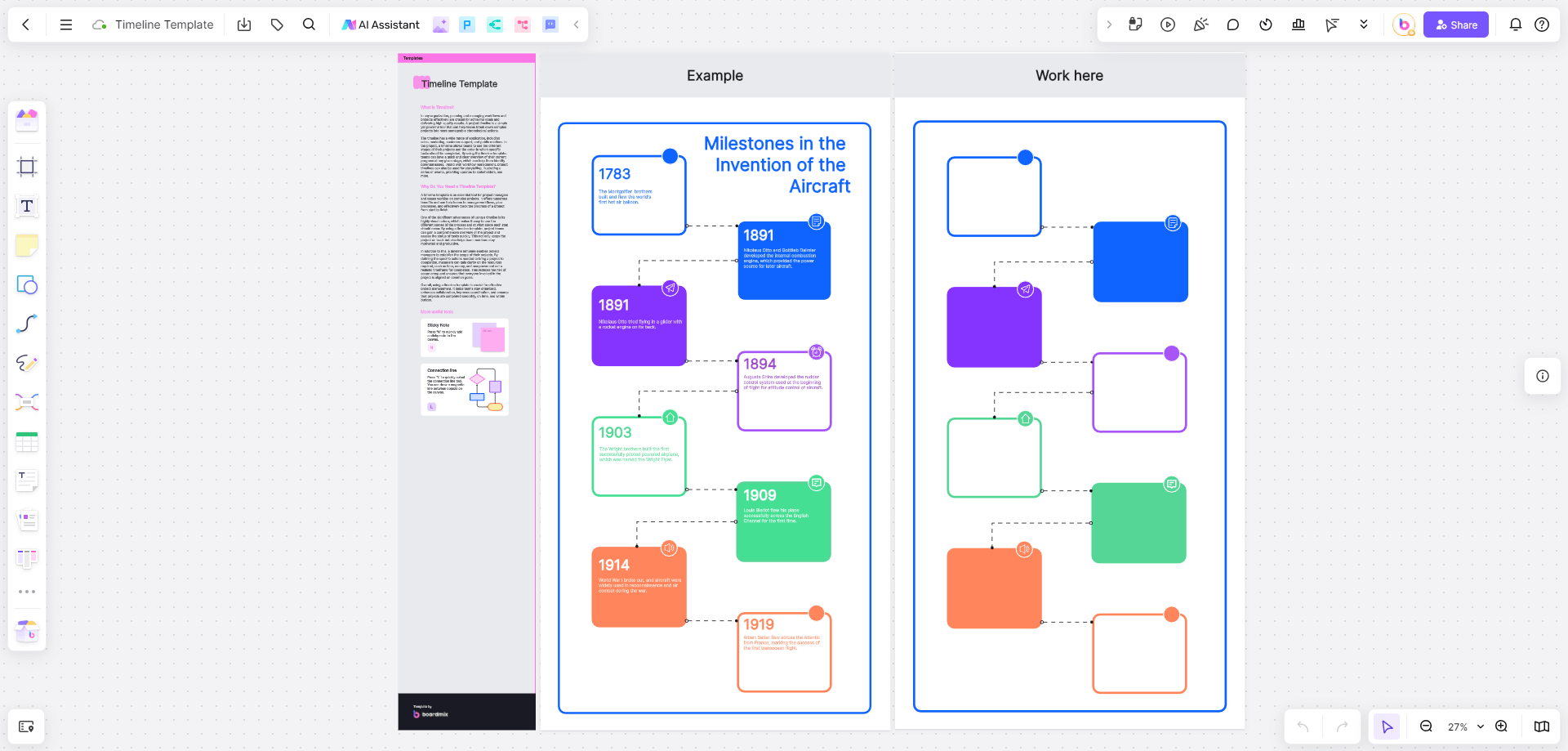
The Atomic Theory Timeline paints a vivid historical tapestry, illustrating the incremental advancements in our understanding of the fundamental building blocks of the universe—atoms. From the philosophical ponderings of ancient Greek intellectuals to the empirical discoveries of modern scientists, this timeline of the atomic model encapsulates centuries of human curiosity and relentless pursuit of knowledge.
Starting with the groundbreaking hypothesis from Greek thinkers like Democritus and Leucippus, who first proposed that all matter was composed of small, indivisible units named 'atoms', the timeline continues through major historical milestones in atomic theory. It charts the path from John Dalton's defining 19th-century postulates, which scientifically formalized the atomic theory, to the quantum mechanical model underpinning our contemporary understanding of atomic structures. Every scientist on this timeline of the atomic model added a layer of complexity and sophistication to the atomic timeline model, refining it into the comprehensive theory we have today.
Timeline of Atomic Theory Scientists
A multitude of brilliant minds contributed to the formation of atomic theory. It all started with Democritus, an ancient Greek philosopher who first suggested the existence of atoms. Fast forward to the 19th century, we have John Dalton who proposed that atoms of the same element are identical, followed by J.J. Thomson's discovery of the electron. As we move further along the timeline of the atomic model, we encounter Ernest Rutherford, who discovered the atomic nucleus, and Niels Bohr, who proposed a planetary model for the atom. The timeline continues to the 20th century with developments in quantum mechanics and advancements by scientists like Erwin Schrödinger and Werner Heisenberg.
Key Discoveries in the Atomic Timeline
Each of these atomic theory scientists made significant contributions to our understanding of atoms:
Democritus: Proposed that matter consists of indivisible atoms.
John Dalton: Asserted that atoms of a single element are identical and different elements have different types of atoms.
J.J. Thomson: Discovered electrons and suggested the "plum pudding" model of an atom.
Ernest Rutherford: Proposed the existence of a dense central nucleus in the atom.
Niels Bohr: Developed the planetary model with electrons revolving around the nucleus.
Modern atomic theory: Evolved with contributions from many scientists, incorporating quantum mechanics and acknowledging the existence of isotopes.
These discoveries have shaped our current understanding of atoms and matter, forming the foundation of modern chemistry.
Atomic Theory Timeline Resources
Creating your own Atomic Theory Timeline can help you better understand and visualize these groundbreaking developments in atomic theory. The following resources can help simplify this process.
Tools for Drawing Atomic Theory Timeline
Boardmix offers a feature-rich platform to create an informative and visually appealing Atomic Theory Timeline. Here are some key features of Boardmix that can enhance your timeline project:
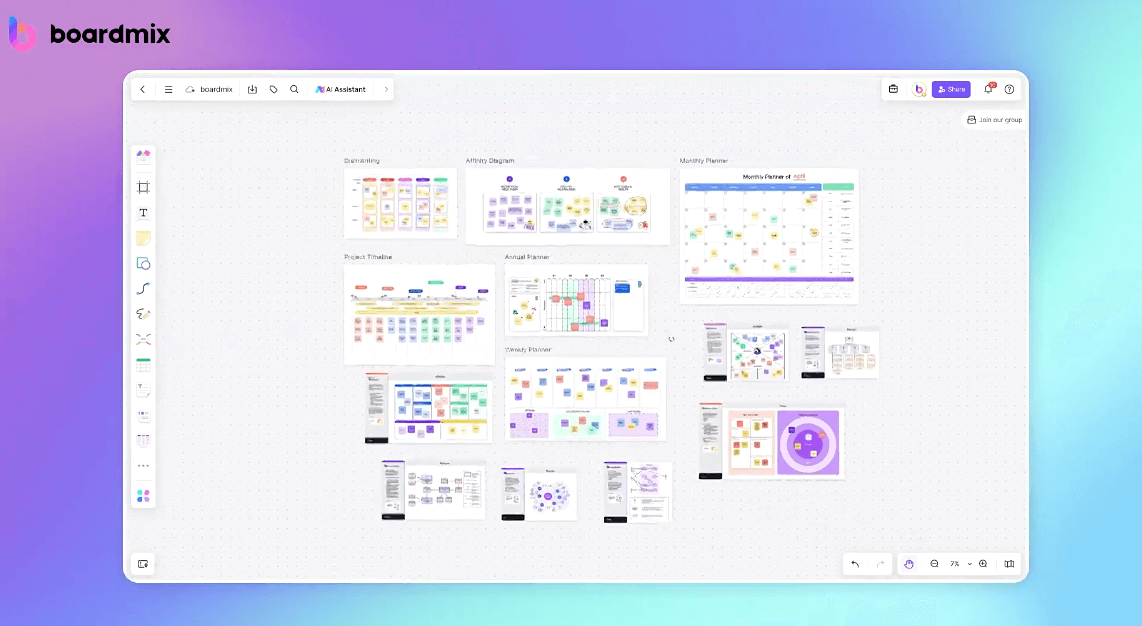
Unlimited Canvas: Boardmix provides an expansive workspace where you can create an extensive timeline covering all major discoveries in atomic theory without worrying about running out of space.

Drag-and-Drop Image Feature: Easily insert pictures of prominent scientists or their atomic timeline models into your timeline of the atomic model, making it more engaging and visually appealing.

Linking and Note Features: Add notes to specific points in the timeline and link them to detailed resources or external references, enriching your timeline of the atomic model with additional context and information.
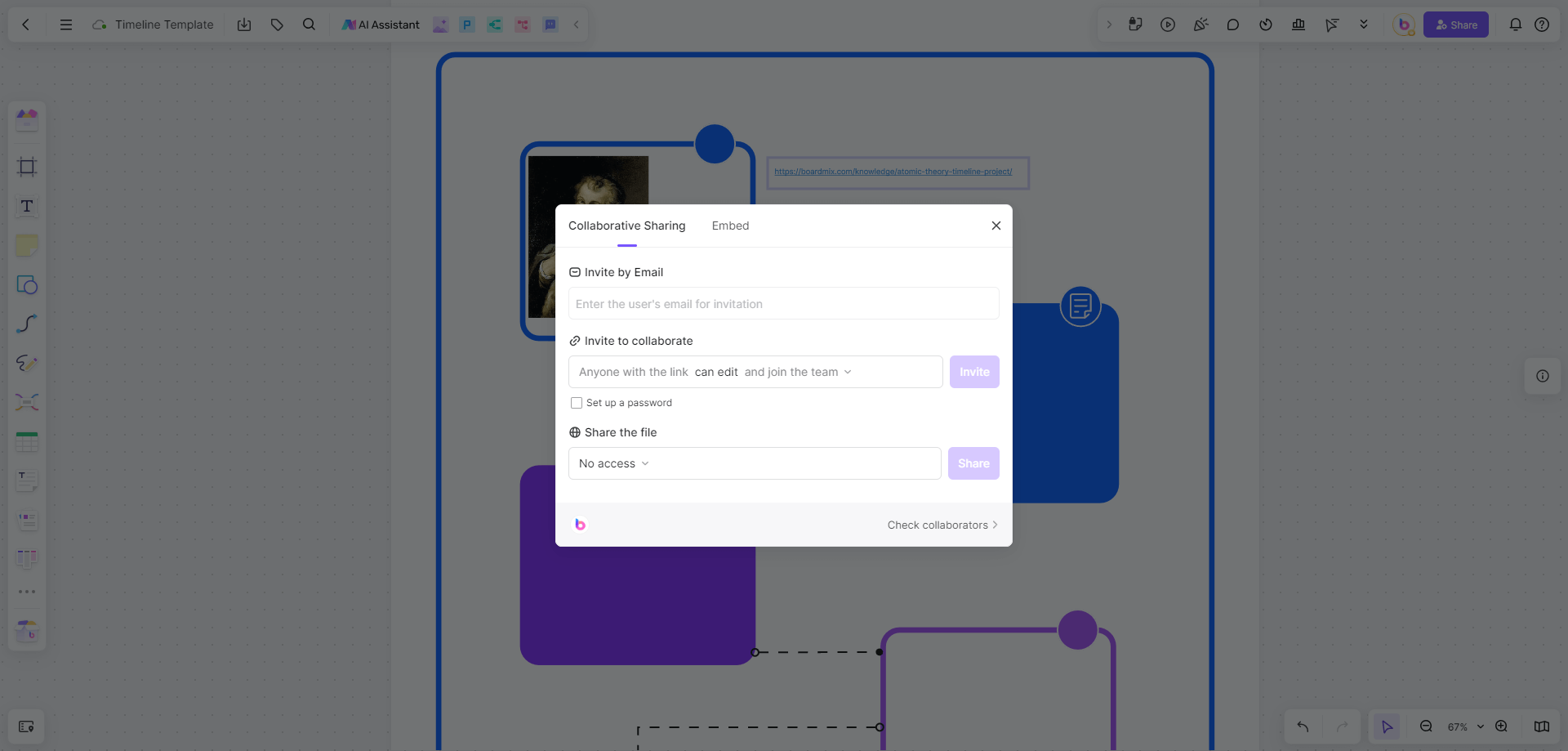
Online Storage and Collaboration: Boardmix's cloud storage feature ensures your work is saved and accessible from anywhere. Moreover, you can collaborate with peers in real-time, making it a perfect tool for group projects.
With these robust features, Boardmix makes creating an Atomic Theory Timeline both efficient and enjoyable.
Atomic Theory Timeline Worksheet
The Atomic Theory Timeline Worksheet is a structured guide for compiling information on atomic theory developments. With Boardmix, you can effortlessly create and customize worksheets that provide a tabular format where you can note down details about each scientist, their discovery, and its impact on atomic theory. Here’s how to use it effectively:
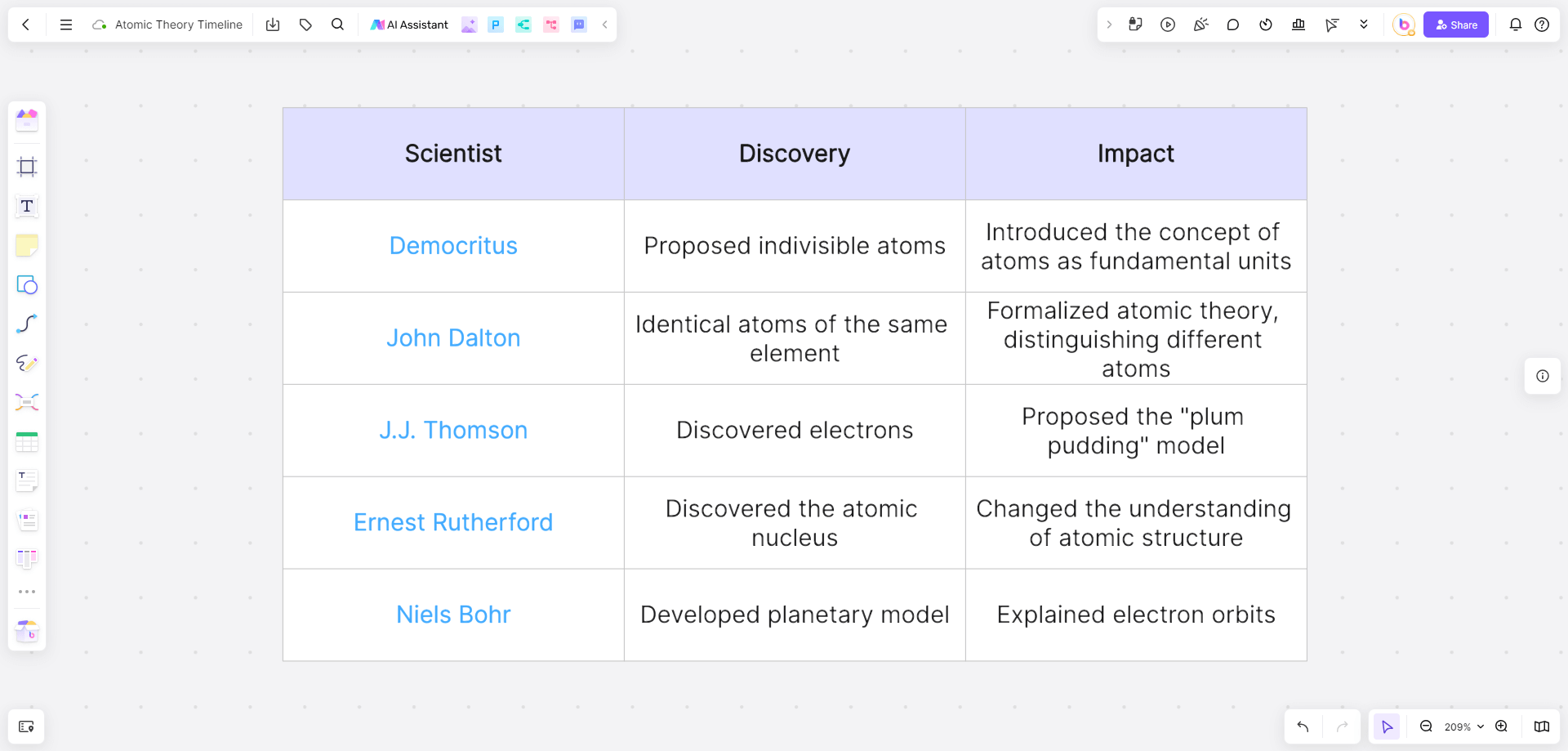
Scientist: Record the name of each scientist who made significant contributions.
Discovery: Briefly describe their key discovery.
Impact: Note how this discovery influenced the development of atomic theory.
Boardmix’s flexible interface allows you to easily add rows and columns, format text, and include images or links within your worksheet. This worksheet can serve as a handy reference when building your timeline on Boardmix. Here’s an example of how it looks:
Atomic Theory Timeline PowerPoint
The Atomic Theory Timeline PowerPoint provides an attractive, ready-to-use template for presenting your timeline. With Boardmix, you can leverage AI functionality to transform your timeline into an engaging, visually dynamic PowerPoint presentation. Here are some steps to make the most out of this feature:

Customization: Insert key points and images that depict the atomic timeline model progression. Boardmix allows you to drag and drop elements easily, ensuring your presentation is visually coherent.
Dynamic Slides: Use Boardmix’s AI to create dynamic transitions and visual effects that enhance the presentation’s appeal. The platform offers various templates and design tools to make your slides captivating.
Collaboration: Share your PowerPoint with others for feedback and collaborative editing. Boardmix’s real-time collaboration feature ensures seamless teamwork, whether you’re working with classmates or colleagues.
This PowerPoint template not only saves time but also ensures your presentation is polished and professional.
Atomic Theory Timeline PDF
Finally, once your timeline is complete, Boardmix offers a feature to export your project as a PDF. This way, you have a portable and easily accessible reference of the Atomic Timeline, perfect for studying, teaching, or sharing with peers. The PDF format preserves the layout and design of your timeline, ensuring that it looks just as impressive in print as it does on screen. Here are some benefits of this feature:
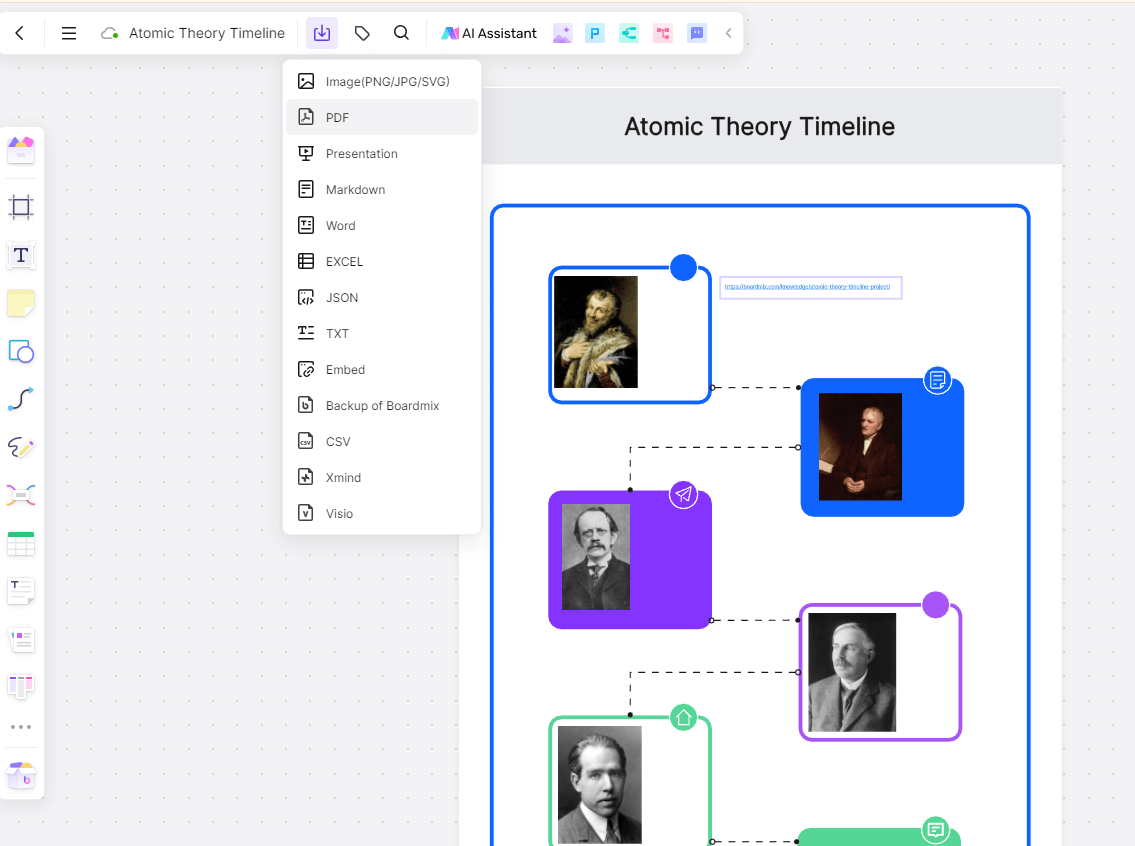
High-Quality Export: Boardmix ensures that the exported PDF maintains the clarity and quality of your original timeline of the atomic model.
Customizable Settings: Adjust settings such as page size, orientation, and margins to suit your needs before exporting.
Easy Sharing: The PDF can be easily shared via email or other platforms, making it convenient for distributing to students, peers, or colleagues.
With Boardmix, you have all the tools you need to create comprehensive and visually appealing resources for the Atomic Theory Timeline, including worksheets, PowerPoint presentations, and PDFs. These features make Boardmix a versatile and powerful tool for both individual and collaborative projects.
Conclusion
The Atomic Theory Timeline serves as a clear, visual way to understand the progression of ideas that define our current understanding of atoms. With resources like a downloadable worksheet, PDF, and PowerPoint presentation combined with the powerful tools offered by Boardmix, creating your own timeline becomes an engaging learning experience.
Using Boardmix for your Atomic Theory Timeline not only facilitates an understanding of this significant aspect of scientific history but also fosters creativity, collaboration, and interactive learning. With its feature-rich platform and user-friendly interface, Boardmix proves to be a go-to resource for anyone looking to delve deeper into the fascinating journey of atomic theory.
By leveraging the capabilities of Boardmix, you can create a comprehensive and visually appealing Atomic Theory Timeline that effectively communicates the development of atomic theory from ancient times to modern-day quantum mechanics. Whether you're a student, teacher, or enthusiast, these tools and resources will help you explore the intricate history of atomic theory in an engaging and informative manner.








